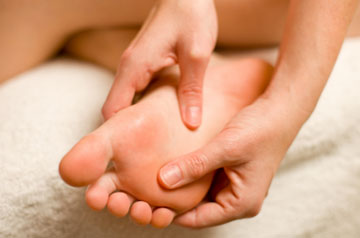
Reflexology
For most people there is one part of their body which, when it's massaged, will send them off into a state of deep relaxation. For some it's the head or hands but for many people it's their feet that do the trick.
Like many complementary therapies, reflexology succeeds where medical services cannot:
- Reducing pain – such as painful periods, lower back pain, kidney stones.
- Pregnancy and birth –many women use reflexology to manage pregnancy symptoms and for birth.
- Cancer – helping to improve the emotional and physical experience of symptoms.
- Mental health – reducing depression and anxiety.
- Post surgery – speeds recovery, especially where medicine cannot help, such as phantom limb pain.
- Fertility - there's been no conclusive research, but reflexology has a strong following in the fertility world.
- Babies – teaching parents to use reflex points for feeding, colic and sleep issues.
- Relaxation – never underestimate the importance of reducing stress; a body that is more relaxed will have a stronger immune system, function better, and in the long term stay healthier than a stressed body.
Reflexologists often work alongside other health care providers to give complementary care in hospices, fertility clinics and in other care settings.
What happens in a reflexology session?
After the initial consultation you sit with your feet up or on a couch. Don't be upset when your therapist gives your tootsies a wipe over with a cloth or wipe, she's not making a response to your personal cleanliness; it's routine practice before she gets to work on your feet. There will be stretches and massage to begin with, then the actual treatment uses fingers and hands to make gentle pressures all over the feet and ankles. The areas that relate to the different parts of the body are worked methodically through both feet. It will be pleasurable and relaxing and sessions usually take 30 minutes to an hour.
If all this profound relaxation is sending you to sleep you can try Chinese reflexology which is a much more energetic, stimulating treatment that will give your body an energy boost.
Why does reflexology work?
Originally known as Zone Therapy, the theory is that reflex areas on the feet correspond to different areas of the body; the toes represent the head going downwards through the rest of the body to the heels, like mini-maps. Pressure onto the reflex points is said to have an energetic effect on the relevant area, reducing stagnation and toxicity and bring us back into balance.
Reflexologists don't diagnose medical problems, but they are skillful at reading the feet and can tell from a change in tissue quality where there might be an issue arising. It's fun to use a reflexology map to see how the hard skin and callouses on your feet relate to the problem areas in your body.
It's not just the feet that have reflex points, the hands and ears have also been mapped out and you can find therapists who specialise in these areas too.
Who is reflexology for?
People of all ages go for reflexology from babies to the elderly and you can find therapists that specialise in many areas of health.
Most of the contraindications are times when you wouldn't dream of getting reflexology anyway, if you have any of these, foot reflexology would not be the obvious choice -
- A deep vein thrombosis
- With an infection, disease or fever
- Athletes foot or verucas
- Fractures
Eating a large meal before you go isn't advisable, nor is going while you have your period as it can stimulate a heavier flow.
For people who hate having their feet touched or are super-ticklish, you can have reflexology on your hands as an alternative, no one need be left out.










